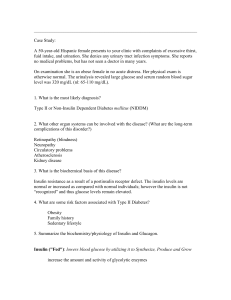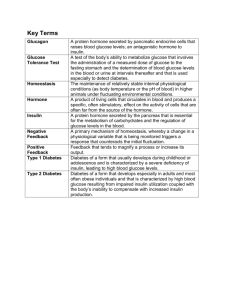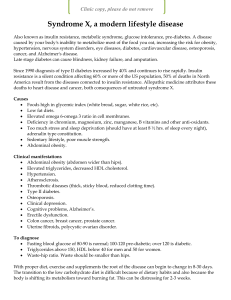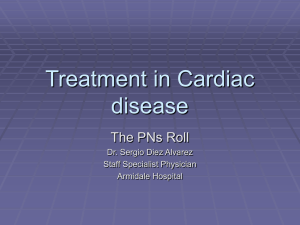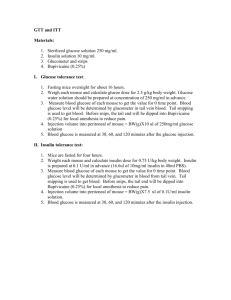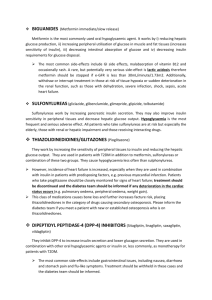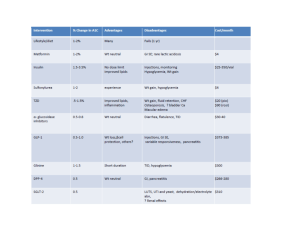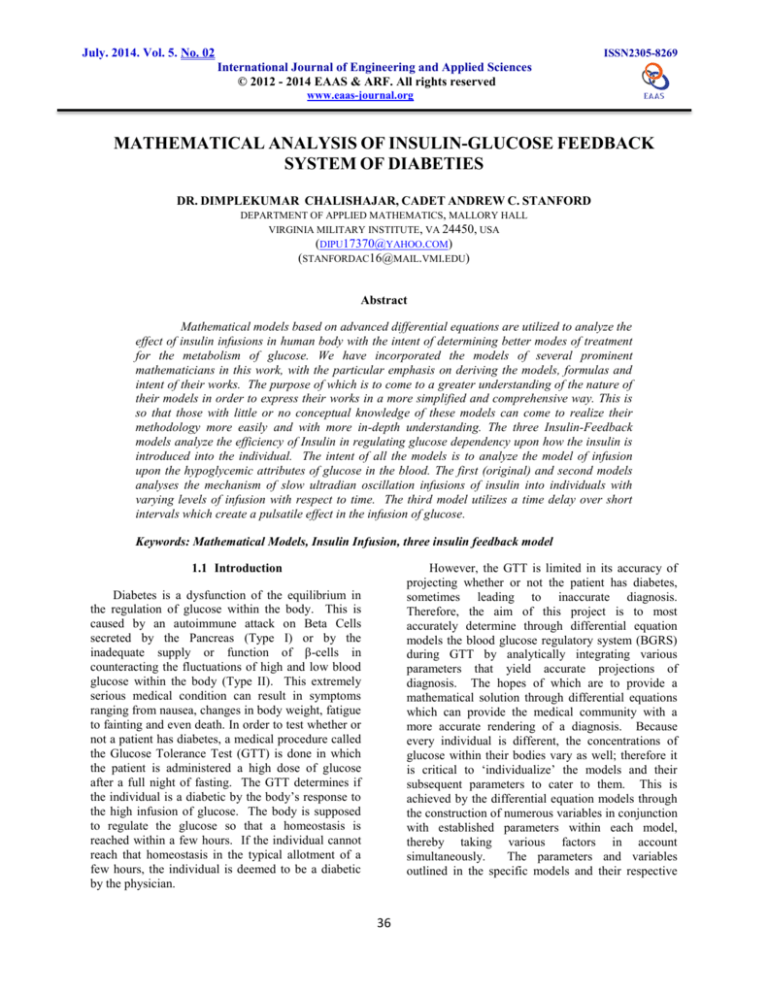
July. 2014. Vol. 5. No. 02
ISSN2305-8269
International Journal of Engineering and Applied Sciences
© 2012 - 2014 EAAS & ARF. All rights reserved
www.eaas-journal.org
MATHEMATICAL ANALYSIS OF INSULIN-GLUCOSE FEEDBACK
SYSTEM OF DIABETIES
DR. DIMPLEKUMAR CHALISHAJAR, CADET ANDREW C. STANFORD
DEPARTMENT OF APPLIED MATHEMATICS, MALLORY HALL
VIRGINIA MILITARY INSTITUTE, VA 24450, USA
(DIPU17370@YAHOO.COM)
(STANFORDAC16@MAIL.VMI.EDU)
Abstract
Mathematical models based on advanced differential equations are utilized to analyze the
effect of insulin infusions in human body with the intent of determining better modes of treatment
for the metabolism of glucose. We have incorporated the models of several prominent
mathematicians in this work, with the particular emphasis on deriving the models, formulas and
intent of their works. The purpose of which is to come to a greater understanding of the nature of
their models in order to express their works in a more simplified and comprehensive way. This is
so that those with little or no conceptual knowledge of these models can come to realize their
methodology more easily and with more in-depth understanding. The three Insulin-Feedback
models analyze the efficiency of Insulin in regulating glucose dependency upon how the insulin is
introduced into the individual. The intent of all the models is to analyze the model of infusion
upon the hypoglycemic attributes of glucose in the blood. The first (original) and second models
analyses the mechanism of slow ultradian oscillation infusions of insulin into individuals with
varying levels of infusion with respect to time. The third model utilizes a time delay over short
intervals which create a pulsatile effect in the infusion of glucose.
Keywords: Mathematical Models, Insulin Infusion, three insulin feedback model
However, the GTT is limited in its accuracy of
projecting whether or not the patient has diabetes,
sometimes leading to inaccurate diagnosis.
Therefore, the aim of this project is to most
accurately determine through differential equation
models the blood glucose regulatory system (BGRS)
during GTT by analytically integrating various
parameters that yield accurate projections of
diagnosis. The hopes of which are to provide a
mathematical solution through differential equations
which can provide the medical community with a
more accurate rendering of a diagnosis. Because
every individual is different, the concentrations of
glucose within their bodies vary as well; therefore it
is critical to ‘individualize’ the models and their
subsequent parameters to cater to them. This is
achieved by the differential equation models through
the construction of numerous variables in conjunction
with established parameters within each model,
thereby taking various factors in account
simultaneously.
The parameters and variables
outlined in the specific models and their respective
1.1 Introduction
Diabetes is a dysfunction of the equilibrium in
the regulation of glucose within the body. This is
caused by an autoimmune attack on Beta Cells
secreted by the Pancreas (Type I) or by the
inadequate supply or function of β-cells in
counteracting the fluctuations of high and low blood
glucose within the body (Type II). This extremely
serious medical condition can result in symptoms
ranging from nausea, changes in body weight, fatigue
to fainting and even death. In order to test whether or
not a patient has diabetes, a medical procedure called
the Glucose Tolerance Test (GTT) is done in which
the patient is administered a high dose of glucose
after a full night of fasting. The GTT determines if
the individual is a diabetic by the body’s response to
the high infusion of glucose. The body is supposed
to regulate the glucose so that a homeostasis is
reached within a few hours. If the individual cannot
reach that homeostasis in the typical allotment of a
few hours, the individual is deemed to be a diabetic
by the physician.
36
July. 2014. Vol. 5. No. 02
ISSN2305-8269
International Journal of Engineering and Applied Sciences
© 2012 - 2014 EAAS & ARF. All rights reserved
www.eaas-journal.org
equations are attained experimentally in laboratories
and are not from my own work.
utilization of glucose within the body, the brain uses
glucose as it’s only energy source and because the
brain is constantly functioning glucose is always
being depleted there, which leads to it being injection
independent, meaning that glucose and insulin
constantly decay there. Further, we came to the
realization of the injection dependent organs and
regions of the body that respond when and influx of
glucose into the body occurs. They mostly occur in
the pancreas which is the main endocrine organ that
secretes the hormone insulin from within the blood
system. This is directly stimulated by eating a meal
in which you will see a quick glucose rise. With this
stimulus, a chemical signal is stimulated within the
pancreas that causes it to produce β-cells that are the
direct producer of the hormone insulin. Finally, the
liver is the major storage place of glucose in the body
which is why our model needs to take into account
the reactions taking place within the liver.
Before proceeding, it is important to
establish a few critical concepts for the casual
observer that will help them come to realizing the
methodology and logical construction of the models.
First of which is that glucose is the main energy biochemical which is later broken down to adenosine
triphosphate (ATP) that is the main energy source
within the body. The blood glucose concentration
has an optimal level for each individual, and any
excessive departure from this optimal concentration
causes severe medical conditions both in excess and
in depletion. The lack of homeostatic regulation of
glucose is the main determinant of medical experts as
to whether or not an individual has diabetes and it is
with this knowledge that we tackled these models.
Normally, the blood glucose levels tend to be autoregulatory but they are susceptible to a wide variety
of hormones and some hormones e.g. Insulin
decreases the blood glucose concentration. Secondly,
we make a passing reference to two hormones due to
their importance in BGRS. The main regulatory
hormone secreted by β-Cells of the pancreas is
insulin. The hormone Insulin is responsible for the
lowering the concentration of glucose and assists in
the combustion of sugar in the tissues and facilitates
glucose uptake in muscles and tissues. Without
sufficient insulin, the body cannot avail itself of all
the energy it needs. The pancreas further secretes αcells which is stored in the liver in the form of
glycogen. This glycogen is converted back into
glucose in times of need, for example, low blood
sugar. The function of the hormone glycogen is to
increase the rate of breakdown of glycogen into
glucose.
1.
2.
Further we have come to a few biological
conclusions pertaining to the nature of the insulinglucose feedback system which are relevant to the
understanding of these models. They were attained
via direct collaboration with the current (2013-2014)
VMI Biology Department Head, Colonel Thompson.
We determined that there exists a Direct Response to
elevated or decreased glucose levels with a critical
level of optimal set glucose levels. Pertaining to the
37
Phase of insulin production: The remote
insulin could be stimulant independent.
Glycogen is stored in the liver, muscles and
in adipose tissue (fat). In between meals,
the pancreas is putting out a subliminal level
of insulin with in very minor levels. The
pancreas secretes digestive enzymes,
produces insulin and glucagon. Glucagon
responds when insulin over regulates
glucose.
It acts as a hormone to
metabolically release glucose from the
stored cites of the body. There also exists 3
types of amino acids that the pancreas is
sensitive to which the pancreas would
produce insulin.
Time delaying factors for insulin
production:
a. Digestion of food products
b. Absorbed through the blood stream
to the pancreas
i. The pancreas is stimulated
ii. Time it takes for the
insulin to travel through
the cells.
iii. Time to activate receptors
to accept glucose into the
cell.
July. 2014. Vol. 5. No. 02
ISSN2305-8269
International Journal of Engineering and Applied Sciences
© 2012 - 2014 EAAS & ARF. All rights reserved
www.eaas-journal.org
APPENDIX C
G.I. Tract
Liver
Tissue Uptake
E
Glucose Pool
G
Hormone
Metabolism
Endocrines
Hormone Pool
H
Figure 1-Schematic Diagram of BGRS System
with the following sign convention: those
hormones which describe an overall decrease or
increase. In blood glucose concentration (BGC)
for example, Insulin, acts to increase H and
hence their contribution to H is taken with a
positive sign convention. While those hormones
which increase BGC for example, cortisol,
contribute negatively to H.
1.2 Formulation of Mathematical Model.
We formulate an appropriate model in two steps
indicated below.
Step I Background Information on the Model
Here we state the assumptions, identify
suitable variables of study and give the law
governing the performance of BGRS.
1) We assume that the following two concentrations
adequately describe the performance of BGRS.
a) Concentration of glucose in the Blood (G)
b) Net Hormonal Concentration (H)
2) Since, the variables G and H change with time,
we consider G and H as dependent variables
while t (time) as the independent variable.
3) From the elementary concentration of the
biological facts, stated above, the logistic law
governing the performance of BGRS may be
written as
By net hormonal concentration, we mean the
cumulative effect of all the relevant hormones
(
)
( )
(G,H)
(1.1)
(1.2)
Where f1 and f2 are the same functions of G and H, while E (t) is the external rate at which the BGC is being
increased.
Step II (Construction of the Model)
Here, we will formulate a second order differential equation model to describe the performance of BGRS
during a GTT.
Let Go and Ho be the optimal values of G and H respectively. Since we are interested in studying the
deviations of G and H from their optimal values, we therefore set,
38
July. 2014. Vol. 5. No. 02
ISSN2305-8269
International Journal of Engineering and Applied Sciences
© 2012 - 2014 EAAS & ARF. All rights reserved
www.eaas-journal.org
G= G-Go and h=H-Ho
On substituting these values of G and H in equations (1) and (2), and using Taylor’s Expansion, we get:
)
[ (
( )
( )
]
( )
(1.3)
[ (
Where (
)
denotes (
)
(
)
(
)
]
(1.4)
) G=Go and H=Ho etc. and C1 and C2 contains terms of second and higher powers in g
and h. At this stage, we note that:
1.
2.
F1 (Go, Ho) =0, F2 (Go, Ho) =0, because it is assumed that G and H have assumed their optimal values Go
and Ho respectively by the time the fasting patient arrives at the hospital.
F1 and F2, being small quantities, may be neglected; for the case of mild diabetes, g and h are small.
With these conditions, equation (4) and (5) yields
[ (
)
(
(
)
) ]
(
( )
(1.5)
)
(1.6)
There are a priori no methods to find the values of the numbers (
)
(
)
(
)
(
) but it is
possible to; ascertain their signs in the following way:
a.
Sign of (
)
For this purpose, we consider g > 0, h=0 (excessive glucose). It follows from the figure that the BGC will be
decreasing on account of the tissue uptake of glucose and the storing of excess glucose in the liver in the form of
glycogen, that is
b.
. In turn, equation (6) implies that (
Sign of (
) must be negative.
)
For this purpose, we consider h>0, g=0 (excessive insulin). In this case,
because excessive insulin will
decrease BGC by facilitating tissue uptake of glucose and by increasing the rate of which glucose is converted to
glycogen. In turn, equation (6) implies that (
c.
Sign of (
) must be negative.
)
Here, we consider h > 0, g=0 (excessive insulin). In this case, the hormone concentration decreases due to hormone
metabolism. In turn, equation (7) implies that (
)
must be negative.
With the consideration of signs above, we re-write equations (6) and (7) as
( )
(1.7)
(1.8)
where a1, a2, a3, and a4 are all positive constants with obvious meanings.
Since it is the BGS that can be measured easily therefore we attempt to eliminate H if possible, between equations
(8) and (9). For this purpose, we proceed as follows.
Differentiation of equation (8) with respect to time gives,
39
July. 2014. Vol. 5. No. 02
ISSN2305-8269
International Journal of Engineering and Applied Sciences
© 2012 - 2014 EAAS & ARF. All rights reserved
www.eaas-journal.org
(1.9)
Substituting the values of
from equation (9), we get
(1.10)
Finally, substituting the value of a2h from equation (8) in equation (11) and rearranging, we get
( )
(1.11)
Where 2α= (a1+a4), wo2= (a1a4+a2a4), M (t) =a4E (t) +
Equation (12) is a second order D.E. with constant coefficient which governs the BGRS after a heavy load of
glucose is ingested.
We note that M (t) is identically zero except for a very short interval in which the glucose load is being
ingested and therefore it can be very effectively dealt by introducing Dirac-Delta function. However, for the present
we are interested in studying the basic system and therefore if t=0 is defined to be the instant when the glucose load
is completely ingested, equation (12) becomes:
(1.12)
Equation (13) may be identified as the standard equation governing damped free vibrations.
1.3 Analysis of the model.
As in earlier cases, we analyze this model in two steps.
Step 1 (Mathematical Solution)
The auxiliary equation of (13) is:
; Whose roots are given by
√
There are three cases according to
⁄ 0. Referring to the discussion of the LCR model, Case III, we
know that every solution g (t) of equation (13) approaches to 0 as
and thus our model confirms to reality in
predicting that the BGC tends to return ultimately to its optimal concentration. It therefore, passes the test of
consistency.
In particular, we consider here the case
; the other two cases can be similarly discussed.
For
, we have;
( )
Where
(
)
(1.13)
Rewriting equation (14) in terms of original variable, we have;
( )
(
)
(1.14)
Equation (15) contains 5 unknowns (including two constants of integration) vis. G o, α, wo, A and δ; the last two
being constant of integration. These unknowns can be determined as: G o, being the BGC before the glucose load is
ingested, is determined by measuring the patients’ blood glucose concentration immediately upon his arrival at the
hospital. The remaining 4 unknowns vis, α, wo, A and δ can be determined from the four equations.
(
)
(1.15)
40
July. 2014. Vol. 5. No. 02
ISSN2305-8269
International Journal of Engineering and Applied Sciences
© 2012 - 2014 EAAS & ARF. All rights reserved
www.eaas-journal.org
By taking four additional measurements G1, G2, G3 and G4 of the patients BGC at time t1, t2, t3 and t4 respectively.
Alternatively, we can determine the five unknowns by the following more effective procedure.
Take n measurements G1, G2,…,G2 of the patients BGC at time t1,t2,…tn respectively (In actual practice, we
take n=7 or 8). Next, we find optimal values of Go, α, wo, A and δ such that the least square error given by:
∑
(
is minimized. The problem of minimizing e can be
easily solved on a digital computer. Ackerman et al.
[1]* has provided a complete Fortran Program for
determining optimal values for Go, α , wo, A and δ.
Obviously, the second method offers a better fit to
the data on the entire time interval sine it involves
more measurements.
2.
3.
The intention of this chapter is to mathematically
derive the equations to the simplified system of
equations model and come to a greater understanding
of the methodology and significance of both models.
Much research has been done on the most appropriate
way to treat and model the feedback system of
glucose and insulin and the body. The mathematics
below display something called a “feedback loop” in
which the stimulation of one system (i.e. eating,
insulin infusion etc.) directly results in the
stimulation of all the other systems, thus yielding the
system equations as seen below. What was found
was that the best way to treat the system in cases of
hormonal dysfunction (Type 1 Diabetes) is via
oscillatory methods of insulin injection as opposed to
a constant rate of infusion or chaotic and sporadically
high dose injections. The reason we came to this
conclusion is the way the mathematics of the
feedback systems work, and how the relationship
between glucose and insulin has a slight time delay,
with oscillations in the concentrations of both within
the blood stream. Although the exact biological
origin of the mechanisms which affect the ultradian
oscillations of insulin secretion is unknown, we
believe it to be from either activity of an
intrapancreatic pacemaker, or the instability in the
insulin-glucose feedback system. In this chapter, you
will see the simplification of several models
presented within the main text analyzed.[1]
From equation (13), we find that there are two
system parameters viz α and wo; out of these we
have to select the one which is a more suitable
and dependable descriptor of the response of
BGRS to a GTT. Based on a number of
experiments, Ackerman et al [1] concluded that a
slight error in the measurement of G causes a
very significant error in the value of α while the
parameter wo was relatively insensitive to the
error in G. Thus wo may be rearranged as a
more faithful parameter for developing criteria
for the diagnosis of diabetes.
Since wo is the natural frequency of the system
therefore we define the corresponding period by
Due to the convenience To be
considered as a suitable parameter to provide a
criterion for the diagnosis of diabetes.
From a wide range of data, collected from
different sources, it is contended that “a value of
less than 4 hours for To indicated normalcy
while appreciably more than 4 hours implied
mild diabetes.” This may be considered as an
analytical basis to interpret the result of a GTT.
Since the usual period between meals is about 4
hours, therefore the above criteria suggest the
interesting possibility that the sociological
factors may also play a role in the BGRS.
II.
(1.16)
Introduction
Step II Interpretation of Results
1.
)
Note: All of the original equations modeling the
original insulin-glucose feedback system developed
by Sturis et al. and its subsequent parameters are
outlined in Appendix A:
The derivations of the original functions (equations
1-12) above are shown below and how it relates to
the simplified model below (13-17):
Analysis of the First Slow Ultradian
Oscillation Model
(2.13)
41
July. 2014. Vol. 5. No. 02
ISSN2305-8269
International Journal of Engineering and Applied Sciences
© 2012 - 2014 EAAS & ARF. All rights reserved
www.eaas-journal.org
The coefficients a and b are simply attained by expanding equation 1 and collecting like terms.
( )
( )
(
(
)
)
(
Where
(2.13.1)
( )
)
=
( )
(2.13.2)
The coefficients c and d are attained by a Taylor polynomial expansion of equation 7. In order to simplify the
derivatives that are the components of the coefficients for the simplified model, we will assume that
.
The coefficient d is identical to f1 (G) while c is the first order expansion of f1(G). The derivation of equation 7 and
how it relates to c and d are outlined below:
( )
(2.7)
((
)
)
( )
[
(
)
(2.13.3)
((
) (
( )
))]
]
(2.13.4)
]
The coefficients e and f are again simply attained by expanding equation 2 and collecting like terms.
(2.14)
(
=
(
)
(2.14.1)
)
(
)
(
)
( )
( )
(2.14.2)
The coefficient’s g and h are derived the first order Taylor polynomial expansions of f 3*f4, k, l, and n are derived
from the first, second and third order Taylor polynomial expansions of f 5 respectively. While the coefficients a and p
come from the combination of constants from the Taylor expansions of the of f2 and the parameter Gin. The
simplified equation above is attained from the equations 8-11 and the respective relationship of those equations is
outlined below:
(2.15)
( )
( )
( )
( ̂)
42
( )
( ̂)(
( )
̂)
(2.3)
July. 2014. Vol. 5. No. 02
ISSN2305-8269
International Journal of Engineering and Applied Sciences
© 2012 - 2014 EAAS & ARF. All rights reserved
www.eaas-journal.org
( )
( ̂)
( ̂))
(
( ̂)
(
) (
(
[
[ (
]
(
) ( ( ̂)(
( ̂)( ) )
(
((
)
]
̂
]
[
[
[
(2.15.2)
)
)) )
((
( ̂) ( ̂))
( ̂)
]
(
(2.15.1)
) ( ( ̂)
( ̂) )
( ̂)
)(
̂)]
(
(
(
(
)
(
( )
(
( ̂)(
(
((
)) )
(
[
(
( ̂)(
) (
( ̂)(
((
)
)) (
)
]
̂
)
(2.15.3)
]
In order to simplify the derivatives that are the components of the coefficients for the simplified model, we will
assume that ∆=
( )
(2.11)
(
[
( )
)
(
) (
(
)
(
(
[
)
( )
)(
(
)
)(
(
(
43
)
(2.15.5)
)
(
) (
)
)
)
(
)
)
(
[
) (
(
(
(
(2.15.4)
)
( )
( )
)]
)
( )
( )
) (
(
(
)
)
]
]
July. 2014. Vol. 5. No. 02
ISSN2305-8269
International Journal of Engineering and Applied Sciences
© 2012 - 2014 EAAS & ARF. All rights reserved
www.eaas-journal.org
( )
[
(
)
]
(2.15.6)
( )
(2.15.7)
For the equations 16-18, the coefficient r is attainted by simple algebra whereby the coefficient of the original model
equations is directly translated to the simplified model. The derivation of which is seen below:
(
(
) (2.4)
(
); (2.5)
(
)
(
)
) (2.6)
(
)
(2(4, 5, 6).1)
III.
dependent upon the mean rate of insulin
infusion. When the infusion is low, the hepatic
glucose production reaches a “saturation” state in
which the “oscillatory component of the insulin
infusion acts to reduce the average plasma
glucose concentration.” Conversely, when the
insulin infusion is high, the hepatic glucose
production is “near total suppression.”
Mathematically speaking, this means that
whether or not equation 15’s second derivative
has a positive or negative sign dictates whether
or not the mean plasma glucose concentration
increases or decreases.
Analysis of the Second Slow
Ultradian Oscillation Model
Introduction
The purpose of further manipulating the first
simplified oscillatory model is to come to greater
conclusions and understanding of specific
attributes of the model with specific regards to
the relevant range of the stated variables. What
was done to the simplified system of equations
was to linearize the functions using Taylor
polynomial expansions on the original system of
equations. This applied to all of the simplified
model equations except for equation 21, which
needed to be expressed in the form of 21-29
because equation 15 contained terms that were
not linear. What was discovered by this system
of equations was that the hepatic glucose
production is the main contributing factor in the
mean rate of plasma glucose. Further, it was
determined by the derivations and graphical
representation of the system of equations that
there exits an upper bound and lower bound to
the hepatic glucose production which is directly
(
(
Equation 19 represents the exogenous insulin
infusion, whereby this equation is directly
attained from equation 13. As you can see from
comparing the two equations, the variables
attached to the coefficient of ‘a’ and ‘b’ are
directly translated from equation 13 to equation
19. However, in equation 19, the parts of the
equation factored with ‘m’ are attained via a
derivation of equation 7. This derivation is
outlined below:
))
(3.1)
((
((
)
)
)
)
(3.2)
In order to come to a greater understanding of equation 21 we have utilized the equations 21-25. The
calculations below reflect the relationship between these equations. First we solved for G(t) in relation to
equation 22 and 23 respectively.
44
July. 2014. Vol. 5. No. 02
ISSN2305-8269
International Journal of Engineering and Applied Sciences
© 2012 - 2014 EAAS & ARF. All rights reserved
www.eaas-journal.org
( )
( )
( )
( ) ( )
( )
(3.3)
( )
( )
(3.4)
( )
( )
( ) ( )
( )
( )
( )
( )
( )
( )
( )
( )
(3.5)
(3.3.1)
( )
( )
( )
( )
( )
(3.3.2)
( )
Next, we went on to solve for the analytical solution to equation 24.
( )
( )
( ( )
( ) ( )
(3.6)
( ) ( )
∫
( ) ( )
( ) ( )
∫
(3.6.1)
( ) ( )
∫
(3.6.2)
Knowing the information above, we went on to solve the analytical solution for equation 25 utilizing equations 26
and 27. This was the most critical evolution of the simplified model because it is in direct relationship to equation
21 as it’s more general solution.
(
( )
(
(
)
))
(3.7)
⟨ ⟩
(3.8)
(3.9)
(
∫ (
∫ (
( )
∫
)
( )
)
(
((
(
(
(
)
[
)
(
[
)
(
))
(3.4.1)
When in equation 20, yj, j = 2 = Ii
)
)
]
∫
(
(
)
45
( )
(
(
)
(
∫
)
∫
[
)
(
))
∫
(
)
)
)]
( )]
(3.4.2)
(
(3.4.3)
(
)
)
(3.4.4)
July. 2014. Vol. 5. No. 02
ISSN2305-8269
International Journal of Engineering and Applied Sciences
© 2012 - 2014 EAAS & ARF. All rights reserved
www.eaas-journal.org
(
[
)
[
( )
(
(
(
( )]
)
)
(
(
(
)]
(
(
⟨ ⟩
⟨ ⟩)( )
)
(
)
⟨ ⟩( )
(3.4.5)
( ))
)
( )
(3.10)
( )
(
)
(
)
(
(
)
(
)
(
)
Set τ = [ (
( )
]
]
{
(
(
(
} {
{
)
)
]
}
))
(3.11)
( ))]
∫{
(
}{
)
} ( )
)
(
} ( )
)
(3.12)
⟨ ⟩
⟨ ⟩
⟨ ⟩
(
⟨ ⟩)
⟨ ⟩
(3.13)
(3.14)
(3.15)
(3.12.1)
⟨ ⟩
(3.12.2)
(3.12.3)
(
)
|
(3.16)
⟨
⟩
⟨ ⟩
(3.17)
(3.18)
⟨ ⟩
(3.19)
46
July. 2014. Vol. 5. No. 02
ISSN2305-8269
International Journal of Engineering and Applied Sciences
© 2012 - 2014 EAAS & ARF. All rights reserved
www.eaas-journal.org
IV.
model is different in that the infusion of insulin is
being done rhythmically with intervals of time in
which no insulin is being exogenously infused. The
period of time in-between pulsatile infusions was
made to be 15 minutes with the amount infused at
each pulse remaining constant throughout the
experiment.
Analysis of Pulsatile Delivery of
Insulin and the Effect of Frequency
As related in the previous glucose-feedback systems
models, the exogenous insulin infusion was done via
ultradian oscillations which left a fluctuation, yet
continuous supply of insulin to the patient. This
( )
V.
(4.1)
(
) (
)
(
( ))
(
)
(4.2)
(
) (
)
(
( ))
(
)
(4.3)
it pertains to the human body’s concentration of both
glucose and insulin. This is because multitudes of
variables, parameters and systems of equations within
systems of equations required this method of
approach. While the original system of equations
above was the foundation of all three chapters, it was
further expanded upon to determine how different
parameters and concentrations of glucose or insulin
would affect the models. While all three models
were looking at different aspects of the glucose
insulin feedback system, the most impressive feature
of all three models is how glucose impacts insulin
concentrations and vice versa within the body. All
three models showed a bounded region of
concentrations of glucose and insulin within the
body, the stimuli of one system created the stimuli of
another proportionally in both increasing and
deceasing values, and the eventual homeostasis of
both system with respect to time.
Conclusion
The aim of this project was to analyze the work
of several prominent mathematicians in this area of
study, and explore the mathematics behind their
systems of equations, models and relationships
thereof. As an undergraduate student, much of these
topics and derivations of models would be far too
complicated and laborious for a student of my caliber
to decipher by themselves and in a reasonable
amount of time. Therefore, the work seen up to this
point was the simplification and derivation of the
models to create a succinct and logical progression
and relationship between them. What was required to
complete this work utilized everything from Taylor
polynomial expansions, highly complex multiderivative and integral transformations, Mat lab
solvers and the amalgamation of multiple systems of
equations to create systems that were intrinsically
connected and revealed information about the nature
of the glucose and insulin feedback systems in the
body. All of which was done so with the intent of
helping make a less advanced mathematics student be
able to come to the realization of many of the key
attributes of higher level doctoral mathematics. While
this project was not intended to discover new
unfounded connections between the glucose insulin
feedback systems, it did provide much clarity that we
believe can be beneficial to many mathematicians.
In the scientific field, mathematics has long been
an integral part of analyzing bodily functions and
reactions to determine cures for illnesses.
Differential equations are often necessary to model
reactions occurring in the body due to the complex
nature of our systems, hormones and much more.
Ordinary differential equations can easily be
expanded to include the more contemporary time
delayed differential equations as explored by more
modern mathematicians.
This special kind of
differential equations models the same systems in
the body but often times has a greater degree of
accuracy because they can ‘time’ the equations to be
expressed at different intervals within a given time
span.
The critical relationship between the glucose and
insulin concentrations within the human body is the
main determinant whether or not an individual suffers
from type I or type II diabetes. The use of advanced
differential equations was required to come to an
analytical solution to the glucose insulin feedback as
47
July. 2014. Vol. 5. No. 02
ISSN2305-8269
International Journal of Engineering and Applied Sciences
© 2012 - 2014 EAAS & ARF. All rights reserved
www.eaas-journal.org
Appendix A and with Definitions of Parameters and Variables
Analysis of the First Slow Ultradian Oscillation Model
( )
(
(
)
(2.1)
)
(2.2)
:
The amount of insulin in the plasma with respect to time.
( ) : “The pancreatic insulin production controlled by the glucose concentration.” This is directly
responsive to an influx of insulin either exogenously or injected into the body.
-E:
“A constant transfer rate for exchange of insulin between plasma and remote compartments”
Ip:
“The amount of insulin in the plasma”
Ii:
“The amount of insulin in the intracellular space”
vp:
“The distribution volume for insulin in the plasma”
vi:
“The effective volume of the intracellular space”
tp:
“The insulin in the plasma as a time constant” represented in
( )
( )
( )
( )
(2.3)
:
“The amount of glucose in the body with respect to time”
“The influx of glucose in the plasma and intracellular space at an exogenously controlled rate.”
) : “The insulin-glucose independent utilization (uptake by the brain and nerve cells)”
) : “The glucose utilization by the muscle and fat cells”
) : “The relationship between the plasma insulin concentration and the cellular glucose uptake”
): “The influence of insulin on the hepatic glucose production”
:
(
(
(
(
(
)
(
)
(
(2.4)
)
(2.5)
(2.6)
: “the inhibition of hepatic glucose production via the insulin stimulating pancreatic insulin production.
: “Physiological action of insulin on the utilization of glucose in correlation with concentration of insulin in a
slowly equilibrating intercellular compartment rather than with the concentration of insulin in the plasma.”
: “Time lag between the appearance of insulin in the plasma and its inhibitory effect on the hepatic glucose
production.
: “The response of the hepatic glucose production to changes in the plasma insulin concentration involves a time
delay. This delay is assumed to be of third order.
x1,x2,x3: Represents the relationship between the time delays of insulin in plasma and its effect on the hepatic
glucose production.
( )
(2.7)
((
)
48
)
July. 2014. Vol. 5. No. 02
ISSN2305-8269
International Journal of Engineering and Applied Sciences
© 2012 - 2014 EAAS & ARF. All rights reserved
www.eaas-journal.org
: “The rate of glucose metabolism within the cell”
: A given parametric value attained by experimental tests that pertains to the process within the function.
: “Glucose”
: “The Volume of Glucose”
: A given parametric value attained by experimental tests that pertains to the process within the function.
( )
(
(
(
)
(2.8)
: Are given parametric values attained by experimental tests that pertains to the process within the function.
: “The Volume of Glucose.”
( )
(2.9)
: A given parametric value attained by experimental tests that pertains to the process within the function.
( )
(2.10)
(
(
)
(
,
, ,
, ,
within the function.
)
: Are all given parametric values attained by experimental tests that pertain to the process
( )
(2.11)
(
)
: A given parametric value which denotes rate of glucose
: A given constant transfer rate
: A given parametric value attained by experimental tests that pertains to the process within the function.
(
(
))
(
)
(2.12)
: Represents the mean rate of the insulin infusion (21mU min-1).
: Represents the amplitude of the insulin infusion.
: Represents time.
: Represents the total period of time set at (120 minutes)
(2.13)
a:
b:
c:
d:
Constant value attained via algebraic methods of equation 1.
Constant value attained via algebraic methods of equation 1.
Constant attained by taking the first derivative of equation 7.
Equivalent to equation 7.
(2.14)
e: Constant value attained via algebraic methods of equation 2.
f: Constant value attained via algebraic methods of equation 2.
(2.15)
g: Attained by the product of a constant equation 9 and first degree Taylor polynomial expansion of equation 10.
h: Attained by the product of a constant equation 9 and first degree Taylor polynomial expansion of equation 10.
k: Attained by the first order Taylor polynomial expansion of equation 11.
49
July. 2014. Vol. 5. No. 02
ISSN2305-8269
International Journal of Engineering and Applied Sciences
© 2012 - 2014 EAAS & ARF. All rights reserved
www.eaas-journal.org
l: Attained by the second order Taylor polynomial expansion of equation 11.
n: Attained by the third order Taylor polynomial expansion of equation 11.
p: The summation of the remaining constants via the Taylor polynomial expansions of the above equations.
(2.16)
(2.17)
(2.18)
r: Attained via algebraic methods of equations 4,5 and 6 respectively.
Analysis of the Second Slow Ultradian Oscillation Model
(
(
))
(3.1)
Note: Equation is the
m: Constant value equivalent to 21mUmin-1
A: Equivalent to 0 when under a constant exogenous insulin infusion and set to 0.3 for oscillatory insulin infusion.
t: Time.
T: Periodization of time equivalent to 120 minutes.
((
)
)
(3.2)
yj: Equivalent to Ip, Ii , x1, x2, x3 because the “time averages of the quantities are the same in the case of an
oscillatory insulin infusion as in the case of a constant infusion.
Yj: Does not depend on time, therefore the value depends on “a linear manner on the mean rate of insulin infusion
and not the amplitude.
Aj: Does not depend on time, therefore the amplitude will be constant (slope=0)
Φj: Denotes the phase shifts of Ip, Ii, x1, x2, and x3.
( )
( ) ( )
( )
(3.3)
Note: Equation 24 is the general solution of equation 21. Equations 21-28 all have to do with the linearization of
equation 15 above. This is because equation 15 is the only equation in the simplified model that has nonlinear
terms.
( )
( )
(3.4)
g: Refer to 2.15.2 above for the coefficients expression.
Ii: Represents the Insulin in the intercellular space.
h: Refer to 2.15.3 above for the coefficients expression.
( )
( )
( )
( )
k: Refer to 2.15.4 above for the coefficients expression.
l: Refer to 2.15.5 above for the coefficients expression.
n: Refer to 2.15.6 above for the coefficients expression.
p: Refer to 2.15.7 above for the coefficients expression.
( )
( ( )
( )
( )
(
(
50
(3.5)
∫
( ) ( )
)
(
))
(3.6)
(3.7)
July. 2014. Vol. 5. No. 02
ISSN2305-8269
International Journal of Engineering and Applied Sciences
© 2012 - 2014 EAAS & ARF. All rights reserved
www.eaas-journal.org
⟨ ⟩
(3.8)
(3.9)
Ai: Represents the amplitude of the Ii
g: Refer to 2.15.2 above for the coefficients expression.
T: Periodization of time equivalent to 120 minutes.
( )
(
(
(
( ))
)
(3.10)
H: Refer to equation 3.9 above.
: Denotes the phase shift of Ii.
J: Refer to equation 3.8 above.
( )
(
)
(
)
(
(
)
)
(
(
)
)
(
(
))
)
(3.11)
Co: Equivalent to equation 3.12 below.
C1-8: The expansion of the square and cube terms of equation x3(t) in equation 3.2 when substituted into equation
3.6
(3.12)
Ko: Equivalent to equation 3.13 below.
K2: Equivalent to equation 3.14 below.
J: Refer to equation 3.8 above.
: Represents a “small term which is a function of the amplitude and phase of the oscillations of I i(t) and x3(t).
⟨ ⟩
⟨ ⟩
⟨ ⟩
(3.13)
k: Refer to 2.15.4 above for the coefficients expression.
l: Refer to 2.15.5 above for the coefficients expression.
n: Refer to 2.15.6 above for the coefficients expression.
p: Refer to 2.15.7 above for the coefficients expression.
⟨ ⟩: Equals approximately 70.9mU for the simplified model and 78.0mU for the original model.
⟨ ⟩)
(
(3.14)
A3: The amplitude of the oscillations of x3(t)
l: Refer to 2.15.5 above for the coefficients expression.
n: Refer to 2.15.6 above for the coefficients expression.
⟨ ⟩
(3.15)
⟨ ⟩: Represents the mean value of
: Represents the “steady state value of G(t).”
: Component of mean value of G(t), which primarily derives from equation 3.2 and 3.5
: Component of mean value of G(t), which primarily derives from equation 3.5
: Refer to equation 3.8 above.
: Represents a “small term which is a function of the amplitude and phase of the oscillations of I i(t) and x3(t).
(
)
|
(3.16)
⟨
⟩
Note:
51
July. 2014. Vol. 5. No. 02
ISSN2305-8269
International Journal of Engineering and Applied Sciences
© 2012 - 2014 EAAS & ARF. All rights reserved
www.eaas-journal.org
( ): Represents the 2nd order partial derivative of equation 2.11 with respect to ⟨ ⟩
: Represents the partial derivative of
of equation 3.5 with respect to ⟨ ⟩
⟨ ⟩
(3.17)
⟨ ⟩: Represented here as the simplified model value.
: Refer to 2.15.6 above for the coefficients expression.
(3.18)
: Represents the “mean rate of insulin infusion.”
⟨ ⟩
(3.19)
⟨ ⟩: Represented here as the original model value.
: Represents the volume of plasma
: A given parametric value attained by experimental tests that pertains to the process within the function.
Analysis of the Pulsatile Infusion of Insulin
( )
(4.1)
(
) (
)
(
( ))
(
)
(4.2)
(
) (
)
(
( ))
(
)
(4.3)
52
July. 2014. Vol. 5. No. 02
ISSN2305-8269
International Journal of Engineering and Applied Sciences
© 2012 - 2014 EAAS & ARF. All rights reserved
www.eaas-journal.org
APPENDIX B
Table 1
Parameters of the original system of equations
Parameter
Vp (1)
Vi (1)
Vg (1)
E (1 min-1)
tp (min)
ti (min)
td (min)
Rm (mU min-1)
a1 (mg l-1)
C1 (mg l-1)
Value
3
11
10
0.2
6
100
36
210
300
2000
Parameter
Ub (mg min-1)
C2 (mg l-1)
C3 (mg l-1)
Uo (mg min-1)
Um (mg min-1)
α (1 mU-1)
β
C4 (mU l-1)
C5 (mU l-1)
Rg (mU l-1)
Value
72
144
1000
40
940
0.29
1.77
80
26
180
Table 2
Parameters of the simplified model
Parameter
a (min-1)
b (min-1)
c ((mU min) mg-1)
d (mU min-1)
e (min-1)
f (min-1)
g (mU-1 min-1)
Value
-0.233
0.0182
0.00479
-43.9
0.0667
-0.0282
-0.0000944
Parameter
h (min-1)
k (mg mU-1 min-1)
l (mg mU-2 min-1)
n (mg mU-3 min-1)
p (mg min-1)
r (min-1)
Value
0.00264
17.5
-0.315
0.00148
80.5
0.0833
APPENDIX C – MATLAB CODES AND GRAPHS
function SolverMain()
% Define Global parameters
global C1 C2 C3 C4 C5 Vg Vp Vi tp ti td E Rm Rg a1 Ub U0 Um alpha beta Gin
SetParameters;
fprintf('Loading parameters... \n');
%load('parameters.mat');
PlotFiGraphs = 0; % 0 for no; 1 for yes
if PlotFiGraphs
Glucose = linspace(0,400,80);
VgScaledGlucose = Glucose*Vg*10;
InsulinI = linspace(0,1000,200);
ViScaledInsulin = InsulinI*Vi/3;
InsulinP = linspace(0,100,200);
VpScaledInsulin = InsulinP*Vp;
53
July. 2014. Vol. 5. No. 02
ISSN2305-8269
International Journal of Engineering and Applied Sciences
© 2012 - 2014 EAAS & ARF. All rights reserved
www.eaas-journal.org
figure
plot(Glucose,f1(VgScaledGlucose),'-o');
figure
plot(Glucose,f2(VgScaledGlucose),'-o');
figure
plot(Glucose,f3(VgScaledGlucose),'-o');
figure
plot(InsulinI,f4(ViScaledInsulin),'-o');
figure
plot(InsulinP,f5(VpScaledInsulin),'-o');
end
% Time Interval
tI = 0;
tF = 1000;
% Initial Conditions
ip_I = 21;
ii_I = 21;
g_I = 216;
x1_I = 0;
x2_I = 0;
x3_I = 0;
options = odeset('RelTol',1e-4,'AbsTol',[1e-4 1e-4 1e-4 1e-4 1e-4 1e-4]);
[Time,Solution] = ode45(@ModelEqns,[tI tF],[ip_I ii_I g_I x1_I x2_I
x3_I],options);
% Name solutions for clarity
Ip = Solution(:,1);
Ii = Solution(:,2);
G = Solution(:,3);
X1 = Solution(:,4);
X2 = Solution(:,5);
X3 = Solution(:,6);
figure
plot(Time,Ip,'-')
figure
plot(Time,Ii,'-')
figure
plot(Time,G,'-')
figure
plot(Time,X1,'-')
figure
plot(Time,X2,'-')
figure
plot(Time,X3,'-')
clear all;
end
____________________________________________________
function res = ModelEqns(t,SOL)
global Vp Vi tp ti td E Gin
54
July. 2014. Vol. 5. No. 02
ISSN2305-8269
International Journal of Engineering and Applied Sciences
© 2012 - 2014 EAAS & ARF. All rights reserved
www.eaas-journal.org
Ip
Ii
G
x1
x2
x3
=
=
=
=
=
=
dIpdt
dIidt
dGdt
dx1dt
dx2dt
dx3dt
SOL(1);
SOL(2);
SOL(3);
SOL(4);
SOL(5);
SOL(6);
=
=
=
=
=
=
% assign variables from SOL vector
%
%
%
%
%
f1(G)-E*(Ip/Vp-Ii/Vi)-Ip/tp;
E*(Ip/Vp-Ii/Vi) - Ii/ti;
Gin-f2(G)-f3(G)*f4(Ii)+f5(x3);
3/td*(Ip-x1);
3/td*(x1-x2);
3/td*(x2-x3);
res = [dIpdt; dIidt; dGdt ; dx1dt ; dx2dt ; dx3dt]; % return solution vector
end
______________________________________________
function SetParameters()
global C1 C2 C3 C4 C5 Vg Vp Vi tp ti td E Rm Rg a1 Ub U0 Um alpha beta Gin
close all;
clc;
% Parameters
C1 = 2000;
C2 = 144;
C3 = 1000;
C4 = 80;
C5 = 26;
Vg = 10;
Vp = 3;
Vi = 11;
tp = 6;
ti = 100;
td = 36;
E = 0.2;
Rm = 210;
Rg = 180;
a1 = 300;
Ub = 72;
U0 = 40;
Um = 940;
alpha = 0.29;
beta = 1.77;
Gin = 216;
%
%
%
%
%
%
%
%
%
%
%
%
%
%
%
%
%
%
%
%
%
-
UNITS
mg/L
mg/L
mg/L
mU/L
mU/L
L
L
L
min
min
min
L/min
mU/min
mg/min
mg/L
mg/min
mg/min
mg/min
L/mU
mg/min
%save('parameters.mat');
End
function Output = f1(x)
global C1 Vg Rm a1
Output = Rm./(1+exp(-x./(a1*Vg)+C1/a1));
55
July. 2014. Vol. 5. No. 02
ISSN2305-8269
International Journal of Engineering and Applied Sciences
© 2012 - 2014 EAAS & ARF. All rights reserved
www.eaas-journal.org
End
function Output = f2(x)
global C2 Vg Ub
Output = Ub.*(1-exp(-x./(C2*Vg)));
end
function Output = f3(x)
global C3 Vg
Output = x./(C3*Vg);
end
function Output = f4(y)
global C4 Vi ti E U0 Um beta
Output = U0+(Um-U0)./(1+exp(-beta*log(y.*(1/(C4*Vi)+1/(C4*E*ti)))));
end
function Output = f5(x3)
global C5 Vp Rg alpha
Output = Rg./(1+exp(alpha*(x3./Vp-C5)));
end
____________________________________________________
300
250
200
150
100
50
0
0
100
200
300
400
500
56
600
700
800
900
1000
July. 2014. Vol. 5. No. 02
ISSN2305-8269
International Journal of Engineering and Applied Sciences
© 2012 - 2014 EAAS & ARF. All rights reserved
www.eaas-journal.org
350
300
250
200
150
100
50
0
0
100
200
300
400
500
600
700
800
900
1000
18000
16000
14000
12000
10000
8000
6000
4000
2000
0
0
100
200
300
400
500
600
700
800
900
1000
0
100
200
300
400
500
600
700
800
900
1000
250
200
150
100
50
0
57
July. 2014. Vol. 5. No. 02
ISSN2305-8269
International Journal of Engineering and Applied Sciences
© 2012 - 2014 EAAS & ARF. All rights reserved
www.eaas-journal.org
200
180
160
140
120
100
80
60
40
20
0
0
100
200
300
400
500
600
700
800
900
1000
0
100
200
300
400
500
600
700
800
900
1000
180
160
140
120
100
80
60
40
20
0
Acknowledgement: We are thankful to Maj. Geoff
Cox for helping us to set up the Mat Lab codes for
the desired results.
Mechanisms Underlying Ultradian Oscillations of
Insulin and Glucose." American Physiological
Society (1991): E801-809. Print.
[3] Tolic, Iva M., Erik Mosekilde, and Jeppe Sturis.
"Modeling The Insulin-Glucose Feedback
System: The Significance of Pulsatile Insulin
Secretion." Journal of Theroetical Biology 207
(2000): 361-75. Print.
REFERENCES
[1]
Keener, James P., and James Sneyd.
MaThematical Physiology. New York: Springer,
1998. 594-607. Print.
[2] Sturis, Jeppe, Kenneth Polonsky, Erik Mosekilde,
and Eve Van Cauter. "Computer Model for
58

